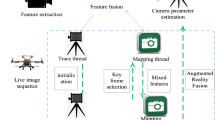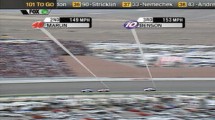Abstract
Often only simple features are employed in mobile augmented reality (AR) due to the limited computational capacity of mobile terminals, which often leads to unsteadiness of the camera tracking. In this paper, we propose a novel approach to real-time camera tracking in mobile AR using hybrid features to alleviate this problem. By integrating feature points and lines as scene features, hybrid features are generated through the process of point/line features extraction, optimization and fusion, and are used in the real-time estimation of camera parameters. A method for image feature optimization is proposed based on the scene structural analysis to meet the computational constraints of mobile terminals. In order to improve the stability of camera tracking, an iterative screening method is proposed to choose a set of stable feature lines, and hybrid features are adaptively constructed based on the composition and geometry of scene features. It is shown from the experimental results that the proposed method produces more stable and smoother camera trajectories in comparison with the method only using feature points, and a good balance is achieved between the stability and the real-time computation of the camera tracking on a mobile platform.
摘要
摘要
针对目前移动增强现实中由于计算性能限制而不得不采用简单特征描述, 导致相机运动跟踪不够稳定的问题, 提出一种基于混合特征的相机实时运动跟踪新方法, 通过综合利用特征点和特征线作为场景特征, 经特征提取、优化和融合后构造为混合特征, 并将混合特征统一用于相机参数实时预估。实验结果表明, 与仅采用特征点的方法相比, 所提出方法生成的相机运动轨迹更为稳定、平滑, 在移动平台上相机运动跟踪的稳定性和计算实时性之间取得了良好平衡。
创新点
提出基于混合特征的相机实时运动跟踪框架; 提出基于场景结构分析的图像特征优化方法; 提出基于迭代式特征线筛选的稳定特征线集构造方法。
Similar content being viewed by others
References
Wu H K, Lee S W Y, Chang H Y, et al. Current status, opportunities and challenges of augmented reality in education. Comput Educ, 2013, 62: 41–49
Chekhlov D, Pupilli M, Mayol W, et al. Robust real-time visual SLAM using scale prediction and exemplar based feature description. In: Proceedings of the IEEE Conference on Computer Vision and Pattern Recognition, Minneapolis, 2007. 1–7
Strasdat H, Davison A J, Montiel J M M, et al. Double window optimisation for constant time visual SLAM. In: Proceedings of the IEEE International Conference on Computer Vision, Barcelona, 2011. 2352–2359
Park Y, Lepetit V, Woo W. Multiple 3D object tracking for augmented reality. In: Proceedings of the IEEE and ACM International Symposium on Mixed and Augmented Reality, Cambridge, 2008. 117–120
Klein G, Murray D. Improving the agility of keyframe-based SLAM. In: Proceedings of the European Conference on Computer Vision, Marseille, 2008. 802–815
Dong Z, Zhang G, Jia J, et al. Keyframe-based real-time camera tracking. In: Proceedings of the IEEE International Conference on Computer Vision, Kyoto, 2009. 1538–1545
Dong Z, Zhang G, Jia J, et al. Efficient keyframe-based real-time camera tracking. Comput Vis Image Underst, 2014, 118: 97–110
Klein G, Murray D. Parallel tracking and mapping for small AR workspaces. In: Proceedings of the IEEE and ACM International Symposium on Mixed and Augmented Reality, Nara, 2007. 225–234
Zeng X, Dong Z, Zhang G, et al. Edge-based adaptive real-time 3D tracking (in Chinese). J Comput Appl, 2011, 31: 20–24
Wagner D, Reitmayr G, Mulloni A, et al. Pose tracking from natural features on mobile phones. In: Proceedings of the IEEE and ACM International Symposium on Mixed and Augmented Reality, Cambridge, 2008. 125–134
Klein G, Murray D. Parallel tracking and mapping on a camera phone. In: Proceedings of the IEEE and ACM International Symposium on Mixed and Augmented Reality, Orlando, 2009. 83–86
Lin L, Yang K, Wang Y, et al. Key issues study for mobile augmented reality system (in Chinese). J Image Graph, 2009, 14: 560–564
Gebril M, Lashkari H. Android mobile augmented reality application based on different learning theories for primary school children. In: Proceedings of the International Conference on Multimedia Computing and Systems, Tangiers, 2012. 404–408
Hrst W, van Wezel C. Gesture-based interaction via finger tracking for mobile augmented reality. Multimed Tools Appl, 2013, 62: 233–258
Jaramillo G E, Quiroz J E, Cartagena C A, et al. Mobile augmented reality applications in daily environments. Rev EIA, 2010, 2010: 125–134
Lin Y, Chen J, Zhou Q, et al. Information visualization and interaction design of mobile augmented reality browser (in Chinese). J Comput Aid Des Comput Graph, 2015, 27: 320–329
Davison A J, Reid I D, Molton N D, et al. MonoSLAM: real-time single camera SLAM. IEEE Trans Patt Anal Mach Intell, 2007, 29: 1052–1067
Trajkovic M, Hedley M. Fast corner detection. Image Vision Comput, 1998, 16: 75–87
Hari C V. Performance evaluation of different line detection algorithm. Int J Model Optim, 2012, 2: 404–407
Rosten E, Drummond T. Machine learning for high-speed corner detection. In: Proceedings of the European Conference on Computer Vision, Graz, 2006. 430–443
Shi J, Tomasi C. Good features to track. In: Proceedings of the IEEE Conference on Computer Vision and Pattern Recognition, Seattle, 1994. 593–600
Canny J. A computational approach to edge detection. IEEE Trans Patt Anal Mach Intell, 1986, 8: 679–698
Duda R O, Hart P E. Use of the Hough transformation to detect lines and curves in pictures. Commun ACM, 1972, 15: 11–15
Miles D. Grammar of Architectural Design. London: Oxford University Press, 1963
Author information
Authors and Affiliations
Corresponding author
Rights and permissions
About this article
Cite this article
Wang, W., Wan, H. Real-time camera tracking using hybrid features in mobile augmented reality. Sci. China Inf. Sci. 58, 1–13 (2015). https://doi.org/10.1007/s11432-015-5360-4
Received:
Accepted:
Published:
Issue Date:
DOI: https://doi.org/10.1007/s11432-015-5360-4




